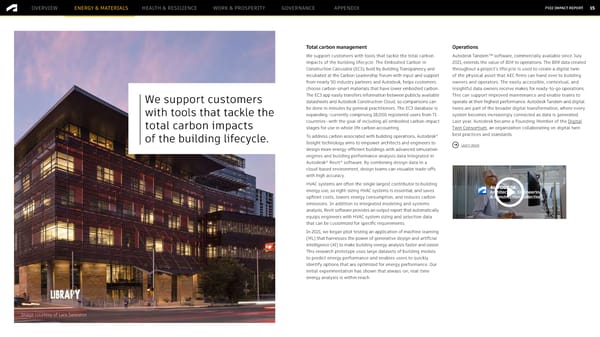OVERVIEW ENERGY & MATERIALS HEALTH & RESILIENCE WORK & PROSPERITY GOVERNANCE APPENDIX FY22 IMPACT REPORT 15 Total carbon management Operations We support customers with tools that tackle the total carbon Autodesk Tandem™ software, commercially available since July impacts of the building lifecycle. The Embodied Carbon in 2021, extends the value of BIM to operations. The BIM datacreated Construction Calculator (EC3), built by Building Transparency and throughout a project’s lifecycle is used to create a digital twin incubated at the Carbon Leadership Forum with input and support of the physical asset that AEC firms can hand over to building from nearly 50 industry partners and Autodesk, helps customers owners and operators. The easily accessible, contextual, and choose carbon-smart materials that have lower embodied carbon. insightful data owners receive makes for ready-to-go operations. We support customers The EC3 app easily transfers information between publicly available This can support improved maintenance and enable teams to datasheets and Autodesk Construction Cloud, so comparisons can operate at their highest performance. Autodesk Tandem and digital with tools that tackle the be done in minutes by general practitioners. The EC3 database is twins are part of the broader digital transformation, where every expanding—currently comprising 18,000 registered users from 71 system becomes increasingly connected as data is generated. total carbon impacts countries—with the goal of including all embodied carbon impact Last year, Autodesk became a Founding Member of the Digital stages for use in whole life carbon accounting. Twin Consortium, an organization collaborating on digital twin ® best practices and standards. of the building lifecycle. To address carbon associated with building operations, Autodesk Insight technology aims to empower architects and engineers to Learn more design more energy-efficient buildings with advanced simulation engines and building performance analysis data integrated in ® ® Autodesk Revit software. By combining design data in a cloud-based environment, design teams can visualize trade-offs with high accuracy. HVAC systems are often the single largest contributor to building energy use, so right-sizing HVAC systems is essential, and saves upfront costs, lowers energy consumption, and reduces carbon emissions. In addition to integrated modeling and systems analysis, Revit software provides an output report that automatically equips engineers with HVAC system sizing and selection data that can be customized for specific requirements. In 2021, we began pilot testing an application of machine learning (ML)that harnesses the power of generative design and artificial intelligence (AI) to make building energy analysis faster and easier. This research prototype uses large datasets of building models to predict energy performance and enables users to quickly identify options that are optimized for energy performance. Our initial experimentation has shown that always-on, real-time energy analysis is within reach. Image courtesy of Lara Swimmer
 Autodesk Impact Report | Generative AI Page 14 Page 16
Autodesk Impact Report | Generative AI Page 14 Page 16